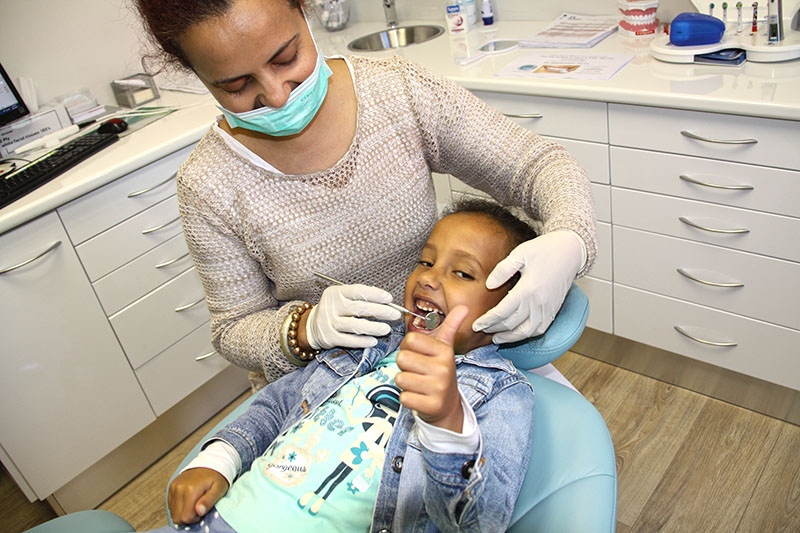A Child's First Dental Visit
When should your child first see a dentist? Experts at the Academy of General Dentistry (AGD) say the ideal time is six months after the first tooth erupts. In my experience, it is useful to only introduce children to the dental practice at this stage.
Fillings
Resin or Composite fillings (white fillings)
Composite fillings have several advantages in children:
- They are tooth-colored. They blend in with the rest of the tooth and other teeth.
- They are bonded to the tooth. This helps seal the filling and prevent decay around it. Placing a plastic filling is more complicated. This means your child may spend more time in the dentist's chair.
Sedative Fillings
Sedative fillings are placed on a tooth to reduce pain. Irritated or inflamed pulp can be the source of this pain. The pulp is the center part of the tooth that contains the blood vessels and nerves. A sedative filling calms the pulp. This reduces the chance that saliva or bacteria will leak into the tooth and irritate the pulp in the future.
Sedative fillings often are placed directly into the tooth. One of the most common types of sedative filling is zinc oxide and eugenol. This contains oil of cloves. Glass ionomers or resin/modified glass ionomers also are used for this type of filling. These materials may be placed on the tooth without any drilling.
A sedative filling is considered a stopgap measure. It often is used in very young children who can't stand to sit in a dentist's chair long enough to receive a regular filling. A sedative filling also may be used for a child who has a tooth injury and needs immediate relief.
Sedative fillings can last for about three to six months. Your dentist should regularly examine the sedative filling to be certain it is still in place and is fulfilling its purpose.
Extractions
Extracting teeth for a child is not very difficult, but other options should be carefully considered before extraction. Many parents feel that their kid's teeth should be taken out instead of being saved, but primary teeth have an important purpose, and removing them prematurely can cause a lot of problems.
Primary teeth encourage the normal development of jaw bones and muscles, and ensure that there is space for the permanent teeth to grow into. They also help guide those teeth into position. The healthier your child's baby teeth are, the stronger their permanent teeth will be!
Fortunately, when necessary, a child tooth extraction is usually a simple procedure. Kids require much less anesthetic than adults and usually have very little to no discomfort during their procedures. They often are more excited about the Tooth Fairy coming and don't worry about possible dental pain.
Parent Information
Protect your children's teeth at home
- Before teeth erupt, clean gums with a clean, damp cloth.
- Brush teeth with a small, soft-bristled toothbrush. Introduce a pea-sized dab of fluoridated toothpaste after 2 years of age, once the child is old enough to spit out the toothpaste after brushing.
- Prevent baby bottle tooth decay: Don't give children a bottle of milk, juice or sweetened liquid at bedtime or when putting down to nap.
- Limit the time your child has a bottle. Your child should empty a bottle in 5 to 6 minutes or less.
- Help your child brush his or her own teeth until 6 years of age. Allow the child to watch you brush, and follow the same brushing pattern to minimize missed spots.
- Avoid foods and treats that increase tooth decay: hard or sticky candies, fruit leather, and sweetened drinks and juice. Offer fruit rather than juice; the fibre in fruit tends to scrape the teeth clean, whereas juice just exposes the teeth to sugar.
At what age are kids old enough to brush their own teeth?
We advise parents to help with brushing up to the age of 7. Or at least help with the evening brushing, which is the most important. This will create the habit of good oral hygiene for the rest of their lives.
Eruption pattern guide:
Click here to view an interactive illustration
Orthodontic Screenings
We offer orthodontic screenings to assess the possible need for orthodontic treatment. Interceptive orthodontic treatment can be done in ages as early as 5 or 6 years. This type of treatment can prevent further need for comprehensive orthodontic treatment.
Mouth Guards
Mouth guards can be manufactured at our practice. An appointment with the dentist or oral hygienist is necessary to take an impression. Mouth guards are extremely important in all contact sports, and we strongly advice our patients to invest in this.
Kids Hygiene Program
At Smith and Van Lierop Dentistry we offer a hygiene program for all the children at the practice. Oral hygiene instructions and cleanings are done by our oral hygienist. At these visits we spend time to ensure that your child is able to brush with the correct technique. 6 monthly appointments are scheduled, and discounted fee structure is used for families with more than one child.



